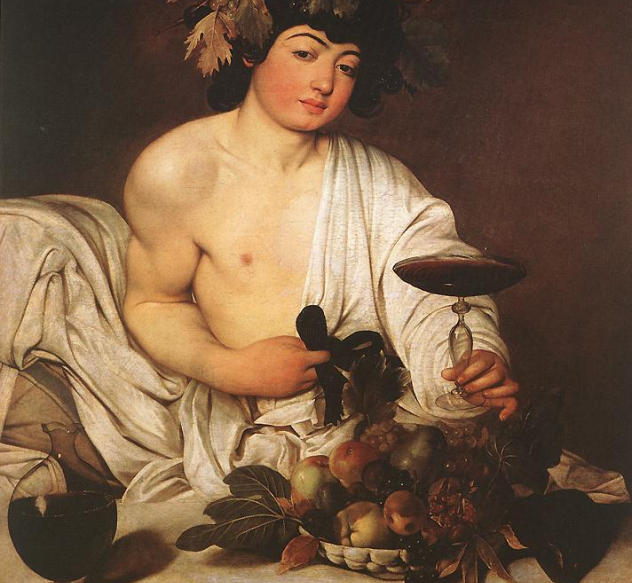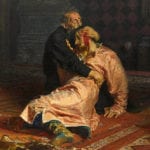 Weird Stuff
Weird Stuff  Weird Stuff
Weird Stuff  Mysteries
Mysteries 10 Tragic Disappearances and Deaths in Joshua Tree National Park
 History
History 10 Ways Childhood Really Sucked in the Old West
 Music
Music 10 Name Origins of Famous Bands from the 1990s
 Religion
Religion 10 Biggest Turnarounds by the Catholic Church
 Weird Stuff
Weird Stuff 10 Unbelievable Times Laws Had Unintended Consequences
 Humans
Humans Ten Historic Women Who Deserve Way More Credit Than They Got
 Movies and TV
Movies and TV 10 Films That Spawned Major Lawsuits
 History
History Ten Times Towns Were Wiped Off the Face of the Earth
 Creepy
Creepy 10 of the Most Disturbingly Haunted Public Houses in the UK
 Weird Stuff
Weird Stuff 10 Niche Subcultures That Are More Popular Than You Might Think
 Mysteries
Mysteries 10 Tragic Disappearances and Deaths in Joshua Tree National Park
 History
History 10 Ways Childhood Really Sucked in the Old West
Who's Behind Listverse?

Jamie Frater
Head Editor
Jamie founded Listverse due to an insatiable desire to share fascinating, obscure, and bizarre facts. He has been a guest speaker on numerous national radio and television stations and is a five time published author.
More About Us Music
Music 10 Name Origins of Famous Bands from the 1990s
 Religion
Religion 10 Biggest Turnarounds by the Catholic Church
 Weird Stuff
Weird Stuff 10 Unbelievable Times Laws Had Unintended Consequences
 Humans
Humans Ten Historic Women Who Deserve Way More Credit Than They Got
 Movies and TV
Movies and TV 10 Films That Spawned Major Lawsuits
 History
History Ten Times Towns Were Wiped Off the Face of the Earth
 Creepy
Creepy 10 of the Most Disturbingly Haunted Public Houses in the UK
10 Incredible Works Of Art Found Hiding In Plain Sight
Most creative people crave attention. That’s why they pester publishers to print their five-million-word S&M vampire novel or beg galleries to hang their Batman paintings. Nobody wants their awesome work to go unrecognized.
Well, nearly nobody does. It turns out that there’s a tiny contingent of painters, musicians, designers, and writers who prefer their work to be subtle—so subtle that decades can pass before anyone even realizes it’s there.
10 Hidden Paintings In Old Books

If you’ve ever picked up an old, dusty novel in a library, you’ll know that books used to be packaged differently. Pages were gilded, so when the book was closed, its fore-edge (the side opposite the spine) appeared golden. That wasn’t the only trick that old-school publishers had up their sleeves. By fanning those pages open in the exact right way, readers could make invisible paintings appear.
Known as “Fore-Edge Paintings,” these proto-Easter eggs weren’t just a cute trick. They often related directly to the contents of the book and possibly even offered commentary on it. Editions of the Holy Bible might recreate Da Vinci’s Last Supper or a pastoral vision of Eden. A biography of a notable figure might include key scenes from their life. In one interesting example, an 1883 copy of the Holy Bible even came with pictures of monkeys in human form, possibly referencing the then-new theory of evolution.
The practice dates right back to the Renaissance, when Titian’s cousin, Cesare Vecellio, decided to use his books as a canvas to make them more beautiful. Today, plenty of libraries have online collections of their fore-edge paintings, so you can judge for yourself how far he succeeded.
9 Caravaggio’s Secret Self-Portrait

Give that he’s one of the greatest artists in history, Caravaggio’s paintings are analyzed to a ludicrous degree. In 2009, a group of researchers took his work Bacchus and subjected it to an infrared viewing process known as multispectral reflectography. In doing so, they accidentally stumbled across the greatest Easter egg in art history. Hidden inside Bacchus’s portrait was a tiny self-portrait of a young Caravaggio.
Experts had known for years that there was something strange about the painting. In 1922, a restorer in Italy noticed what appeared to be a tiny figure peering out of Bacchus’s carafe of red wine. But it wasn’t until science caught up with speculation that researchers could confirm it was a secret portrait of the artist. Although you really have to squint to see it even in the infrared version, the tiny Caravaggio is apparently holding a paintbrush and working at an easel, which presumably features the very Bacchus portrait you’re looking at.
Not everyone agrees. At least one Caravaggio expert has called the work inconclusive. Given what we know about artists and secret messages, though, it wouldn’t surprise us to learn that Caravaggio did it deliberately.
8 Radiohead’s Hidden Concept Album
We’ve all heard the bizarre conspiracy theories about great albums. Mostly, they’re the result of fans with too much time and cannabis on their hands. But the Radiohead “01 10 album” theory is a little harder to dismiss. There’s a lot of evidence that the miserablist British band hid an entire secret album on their 1997 album OK Computer and didn’t tell anyone about it for 10 whole years.
To explain this, we’re going to need to disappear down a rabbit hole concerning the number 10. In 2007, Radiohead shocked the music world by announcing the imminent release of In Rainbows only 10 days in advance. The album debuted on October 10 (in other words 10/10) and was preceded by 10 cryptic messages involving the letter X (the Roman numeral for 10). When people clocked that this was 10 years after the release of OK Computer, things went nuts.
OK Computer’s working title was Zeroes and Ones. People realized that if OK Computer could be represented as 01 and In Rainbows as 10, they made a complimentary string of binary code. In a leap of logic too intense for us, they decided to alternate the tracks of each album and play them with a 10-second fade. The result was a whole new secret album.
Aside from fitting together musically, the lyrics of each OK Computer song seemed to be echoed in their In Rainbows counterparts. Listened to in the correct way, both albums combined to create a third, distinctive album known as OK Rainbows. Although it must’ve taken a ton of effort, vocalist Thom Yorke has never confirmed or denied the album’s existence.
7 Goldeneye‘s Buried Spectrum Games
Many of you reading this will have fond memories of playing Goldeneye 007 on the Nintendo 64. Aside from being more fun than should legally be allowed, it revolutionized gaming. It also provided an unexpected historical service. Fifteen years after the game first came out, it was discovered that Goldeneye’s code was hiding 10 playable classic ZX Spectrum games.
Unlike most of the items on our list, the hidden games already existed outside of Goldeneye and had been available to buy in the 1980s. But they were restricted almost exclusively to the British market, whereas Goldeneye was a global phenomenon. For over a decade, gamers in the US, Japan, and Europe had access to classic Brit titles like Atic Atac, Sabre Wulf, Jetpac, and Knight Lore without even realizing it. It wasn’t until someone decided to try digging through the code in 2012 that their existence finally came to light.
Weirdly, this act of preservation may have been unintentional. The makers of Goldeneye owned the rights to some Spectrum games and were working on an emulator to bring them to the N64. Apparently, they simply used Goldeneye as a vehicle for testing its feasibility, not expecting anyone to ever uncover the disabled code. That all 10 games are completely playable with a patch is sheer good luck.
6 Hidden Designs In Modern Passports
Before reading on, go dig out your passport. What do you see? No matter where you’re from, the inside pages will likely contain patterns, pictures, or graphics of varying degrees of coolness. If you’re Canadian, though, your passport will come with a little extra surprise. View its pages under UV and you’ll uncover awesome graphic designs that are invisible in normal light.
Although created for a practical purpose—to make forging passports even harder—the designs are incidentally stunning to look at. One page features an old-fashioned smiling sun and a glowing compass, while another makes fireworks magically appear over the Canadian parliament building.
These Easter eggs aren’t unique to Canada. The new design issued by Norway in 2014 includes a minimalist mountain scape over which images of the Northern Lights appear under UV. Coolest of all might be the Finnish passport. By flipping through its pages at high speed, you can uncover a charming secret animation of a moose going for a stroll.
5 Mozilla’s Apocalyptic Doomsday Novel

Search engines and browsers have never been short of Easter eggs. Chrome currently has a secret game involving a cactus-jumping T-rex, and if you’ve never typed “do a barrel roll” into Google, prepare to have your mind blown. But none can approach Mozilla for dedication or creepiness. Since their earliest days, the developers of Netscape and Firefox have been secretly writing an apocalyptic novel in the background of your browser.
To open the latest verse, all you need to do is type “about:mozilla” into the search bar. What comes up is nothing short of terrifying. On a blood-red background, you should see the words:
The twins of Mammon quarrelled. Their warring plunged the world into a new darkness, and the beast abhorred the darkness. So it began to move swiftly, and grew more powerful, and went forth and multiplied. And the beasts brought fire and light to the darkness.
Known as the Book of Mozilla, the collected tome currently consists of five similar verses, all of which sound like the deranged whispers of your darkest nightmares. While the book is currently pretty small, it’s added to every few years. There even seems to be a narrative developing, although it’s kind of hard to tell. Maybe in a century or so it’ll all finally become clear.
4 Hidden Designs On Microchips

We’re going to go out on a limb here and guess that some of you reading this have Samsung Galaxy phones. If so, you’re in for a treat. Contained inside your phone is a tiny microchip called the Infineon PMB5703. If you remove it from your phone and start disassembling it, you should find five tiny artworks hidden on its surface, each only 2 microns high.
While one is simply a message declaring, “If you can read this you are much too close,” the others include a smiley face, a baby duck, and a dragon called Grisu. Cool as that is, these are far from a one-off. Since the 1970s, workers have been leaving private designs on the surfaces of chips, including their initials, images of Sonic the Hedgehog, thoughtful sharks, and dinosaurs eating dollar signs.
According to Chipworks, the company that found many of them, they can be considered genuine works of art. While some are used simply to claim ownership of a chip, others make jokes, satirize the company behind the product, or just express something about the creator. If you own a product with a chip inside (since you’re reading this, you probably do), you might well be carrying around a tiny artwork without even realizing it.
3 The Ignored Masterpieces Of Video Game Backgrounds

In our age of intricately designed, free-roaming games, it’s not uncommon to hear people rhapsodizing about the beauty of a virtual world. Artist Jon Gourley went one further. In 2014, he guest-curated an exhibition at online gallery Manifesto-ish, dedicated to the beauty of paintings in video games.
His subject was the sort of decorative paintings that pop up on the walls of games like Final Fantasy VIII and old eight-bit platformers. While they were usually designed just to add atmosphere to a location, or stop all the walls from looking like copy and paste jobs, Gourley contends they can stand as artistic works in their own right. Every day for a month, he posted new works to the Manifesto-ish gallery, highlighting stuff that was weird, freaky, and occasionally even beautiful.
Although Gourley’s intention was to satirize arguments about whether or not video games constitute art, the paintings evidently touched some of his audience. Following his stint at Manifesto-ish, other outlets began publishing their own pieces, seriously analyzing the artistry of in-game statues and paintings. They might take a back seat to the challenges and puzzles, but those images in the background of your favorite game are arguably overlooked masterpieces.
2 Arcade Fire’s Invisible Epic
Although they’re more cerebral than the average, run-of-the-mill group, Arcade Fire is nowhere near Radiohead levels of intellectual insanity. That only makes their secret epic song even more interesting. Hidden away on Reflektor, it requires more tinkering to unlock than a secret level in Super Mario World.
To access it, listeners first have to find the hidden track zero in the CD version’s pregap. A collection of data that kicks in before the CD has actually loaded; the pregap has become the go-to place for musicians wanting to hide a bonus track. What makes Reflektor different is what comes next. By taking the pregap and playing it in sync with a backward version of the band’s song “Supersymmetry,” you’ll unleash a hidden song as majestic as it is invisible.
Featuring weird tape noises, spooky echoing voices, and bizarre hooks, the unnamed combination track has been called a masterpiece in its own right. NME called it “godly” and said it made “for a spooky but transcendent listen.”
1 Shakespeare’s Only Surviving Portrait (Maybe)

Your first thought on reading the title to this entry was probably “what?” We’ve had at least two portraits of Shakespeare for centuries, and one ranks among the most iconic images in the world. What you may not know is that both were created posthumously. Since no contemporary portraits have survived, we have no way of knowing how accurate those that we have are. At least, we didn’t until May 2015, when historian Mark Griffiths discovered a picture of Shakespeare hiding on a 400-year-old book on plants.
For centuries, academics had considered the four figures adorning the 1598 book The Herball or Generall Historie of Plantes by John Gerard to be allegorical. But when Griffiths discovered that one of them was Gerard himself, he decided to investigate the others. Using investigative techniques to decode the opaque Elizabethan references, he deduced that one was botanist Rembert Dodoens, and another was Lord Burghley. The last one, he concluded, was Shakespeare.
If true, this would be one of the great artistic finds of the century. We say “if” because not everyone agrees. Griffiths’s technique involves doing Dan Brown–style stuff like noting a figure four and an arrowhead with an “E” on it above the portrait. In Elizabethan times, “quater” was a slang term for four in cards. Add an “E” on the end and it becomes quatere, or the Latin verb for “shake.” The arrow next to it could then be seen as a spear, creating either the answer to a mind-blowing riddle or a series of meaningless coincidences. While Griffiths goes for mind-blowing riddle, his detractors disagree.
But that’s the beauty of these old and hidden works of art: You never know when you might stumble across something sensational. Who knows? In a few years’ time, maybe someone will find a real Shakespeare portrait locked away in their Mozilla browser, which can only be accessed when you play OK Rainbows backward.








